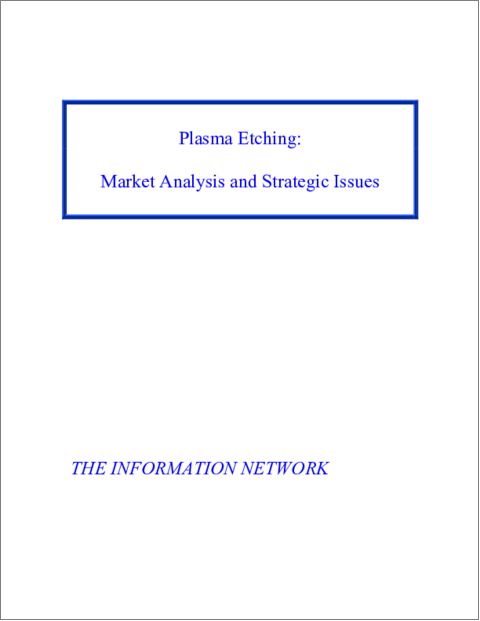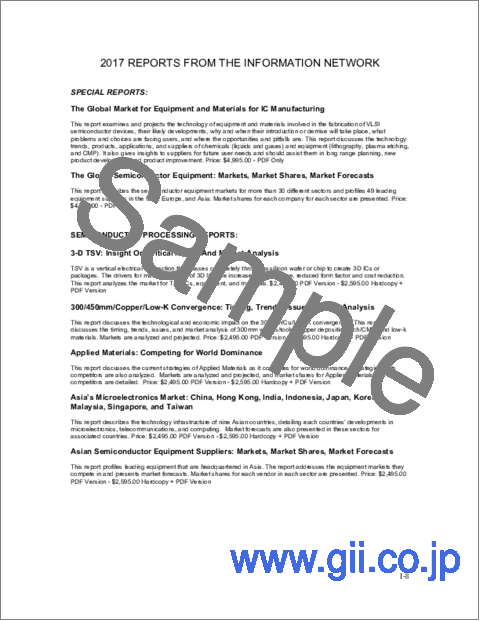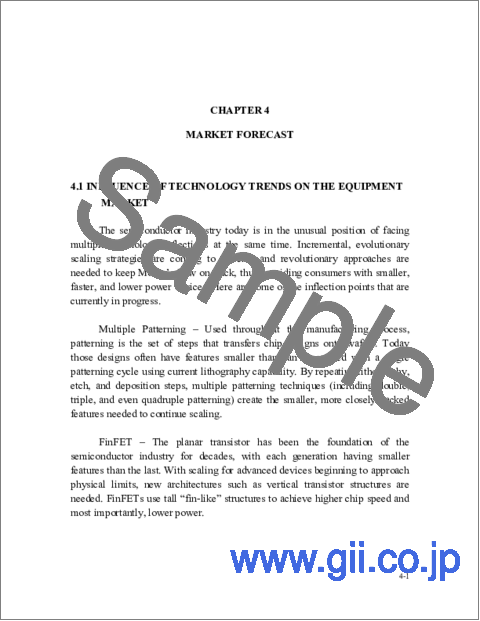|
|
市場調査レポート
商品コード
1266887
プラズマエッチング:市場分析と戦略的課題Plasma Etching: Market Analysis and Strategic Issues |
||||||
| プラズマエッチング:市場分析と戦略的課題 |
|
出版日: 2024年03月01日
発行: Information Network
ページ情報: 英文
納期: 2~3営業日
|
- 全表示
- 概要
- 図表
- 目次
当レポートでは、半導体業界におけるプラズマエッチング装置のユーザーとサプライヤーの双方に影響を与える戦略的課題を取り上げます。ドライエッチングとストリッピングの市場を分析・予測し、各分野の市場シェアを示しています。
目次
第1章 イントロダクション
第2章 エグゼクティブサマリー
第3章 技術的問題と動向
- イントロダクション
- 処理の問題
- 塩素プロセスとフッ素プロセス
- 多層構造物
- 新素材
- GaA処理
- プラズマストリッピング
- フォトレジスト剥離
- Low-K除去
- 安全性の問題
- システム設計に関する考慮事項
- ガスハンドリング
- リアクタークリーニング
第4章 市場予測
- 技術動向が機器市場に与える影響
- 市場予測の前提条件
- 市場分析
- プラズマエッチングおよびプラズマストリップシェア
- 市場予測
第5章 戦略的問題:ユーザー
- ユーザーのニーズの評価
- デバイスアーキテクチャ
- ウエハスタートとスループット要件
- ウエハサイズ
- ベンダーのベンチマーキング
- 価格
- ベンダーのコミットメントと態度
- ベンダーの能力
- システム機能
- コスト分析
- 設備価格
- 設置費用
- 維持費
- 維持費
- 隠れたコスト
- ユーザー- サプライヤーの相乗効果
- 設備評価時のフィードバック
- デバイス製造時のフィードバック
第6章 戦略的問題:サプライヤー
- 競合
- 顧客との相互関係
- クラス1のクリーンルームにおける設備の互換性
LIST OF FIGURES
- 3.1. Various Enhanced Designs (a) Helicon, (b) Multiple ECR, (c) Helical Resonator
- 3.2. Schematic of Inductively Coupled Plasma Source
- 3.3. Schematic of the HRe Source
- 3.4. Schematic of the Dipole Magnet Source
- 3.5. Schematic of Chemical Downstream Etch
- 3.6. Silicon Trench Structure
- 3.7. fin/STI Etch Requirements
- 3.8. FinFET Gate Etch Requirements
- 3.9. Dual Damascene Dielectric Etch Approaches
- 4.1. Trends in Minimum Feature Size for Dynamic RAMS
- 4.2. Market Shares for Dry Etch Equipment
- 4.3. Market Shares for Strip Equipment
- 4.4. Distribution of Etch Sales by Type
- 4.5. Geographical Distribution of Equipment Revenues
- 4.6. Etch System Demand by Geometry
- 5.1. Typical First Year Single Wafer System Cost Analysis
- 6.1. Relationship Between Device Yield and Particles
- 6.2. Sources of Particles
- 6.3. Relationship Between Die Yield and Chip Size
LIST OF TABLES
- 3.1. Silicon Wafer Usage
- 3.2. Plasma Source Comparison
- 3.3. Typical Process Specifications
- 4.1. Worldwide Dry Etch Market Shares
- 4.2. Worldwide Dry Strip Market Shares
- 4.3. Worldwide Market Forecast of Plasma Etching Systems
- 4.4. Distribution of Etch Sales by Device by Vendor
- 4.5. Number of Equipment Systems by Geometry
- 5.1. Levels of Integration of Dynamic Rams
- 5.2. Interconnect Levels of Logic Devices
- 6.1. Etch Process Specifications
Etching equipment (or etcher) has high technology barriers due to the complexity and strict requirement of uniformity in the etching process, and etch is a key process in making critical dimensions within a chip. This area is primarily dominated by LAM Research, Tokyo Electron, and Applied Materials. These global leaders offer full etch equipment portfolio ranging from silicon etch (trench, gate, TSV), dielectric etch (Via, Contact, Side wall) and metal etch.
The etching process shapes thin films into certain patterns desired by wafer fabs by using chemicals, reaction gases or ion chemical reaction. In non-EUV, multi-patterning increases lithography and etch/cleaning steps. 14nm requires double-patterning, with KrF 193nm immersion DUV lithography tool, and 7nm requires quadruple-patterning. We see a rising number of etch steps as the process node moves to more advanced nodes, which could drive up etch demand. However, the use of EUV lithography tool in 7nm+ and 5nm could reduce the need for multi-patterning and thus reduce etching steps.
Advanced pulsing technology provides the extremely high materials selectivity, depth control and profile control needed by customers to create densely packed, high-aspect-ratio structures in 3D NAND, DRAM and logic, including FinFETs and emerging gate-all-around architectures.
This report addresses the strategic issues impacting both the user and supplier of plasma etching equipment to the semiconductor industry. Markets for dry etching and stripping are analyzed and projected, and market share presented by each sector.
Table of Contents
Chapter 1. Introduction
- 1.1. The Need For This Report
Chapter 2. Executive Summary
- 2.1. Summary of Technical Issues
- 2.2. Summary of User Issues
- 2.3. Summary of Supplier Issues
- 2.4. Summary of Market Forecasts
Chapter 3 Technical Issues and Trends
- 3.1. Introduction
- 3.2. Processing Issues
- 3.2.1. Chlorine Versus Fluorine Processes
- 3.2.2. Multilevel Structures
- 3.2.3. New Materials
- 3.2.4. GaAs Processing
- 3.3. Plasma Stripping
- 3.3.1. Photoresist Stripping
- 3.3.2. Low-K Removal
- 3.4. Safety Issues
- 3.4.1. System Design Considerations
- 3.4.2. Gas Handling
- 3.4.3. Reactor Cleaning
Chapter 4. Market Forecast
- 4.1. Influence of Technology Trends on the Equipment Market
- 4.2. Market Forecast Assumptions
- 4.3. Market Analysis
- 4.3.1. Plasma Etch and Plasma Strip Shares
- 4.3.2. Market Forecasts
Chapter 5. Strategic Issues: Users
- 5.1. Evaluating User Needs
- 5.1.1. Device Architecture
- 5.1.2. Wafer Starts and Throughput Requirements
- 5.1.3. Wafer Size
- 5.2. Benchmarking a Vendor
- 5.2.1. Pricing
- 5.2.2. Vendor Commitment and Attitudes
- 5.2.3. Vendor Capabilities
- 5.2.4. System Capabilities
- 5.3. Cost Analysis
- 5.3.1. Equipment Price
- 5.3.2. Installation Costs
- 5.3.3. Maintenance Costs
- 5.3.4. Sustaining Costs
- 5.3.5. Hidden Costs
- 5.4. User - Supplier Synergy
- 5.4.1. Feedback During Equipment Evaluation
- 5.4.2. Feedback During Device Production
Chapter 6. Strategic Issues: Suppliers
- 6.1. Competition
- 6.2. Customer Interaction
- 6.2.1. Customer Support
- 6.2.2. Cleanroom Needs in the Applications Lab
- 6.3. Equipment Compatibility in Class 1 Cleanrooms
- 6.3.1. Footprint Versus Serviceability
- 6.3.2. Particulate Generation
- 6.3.3. Automation
- 6.3.4. Etch Tools




